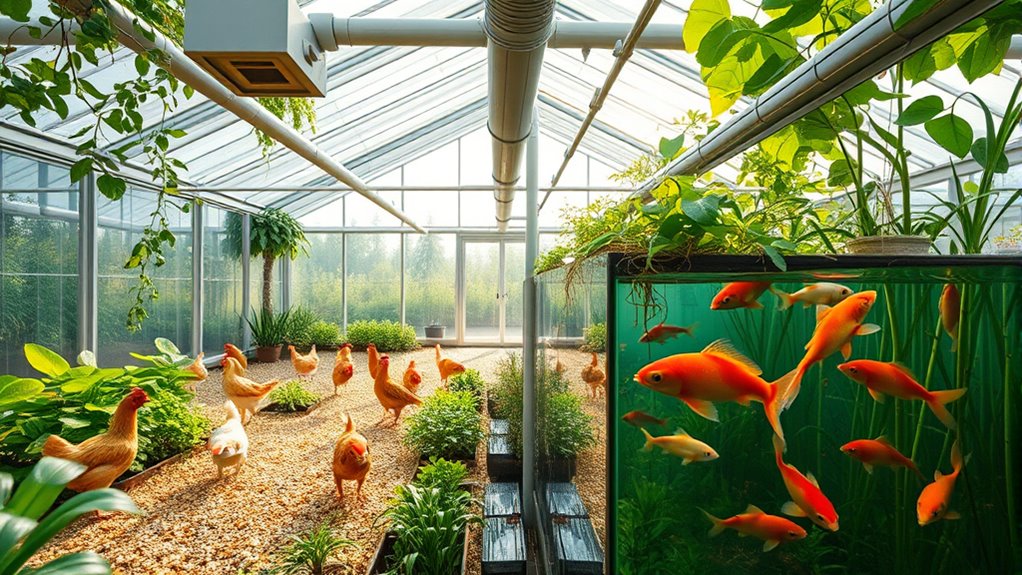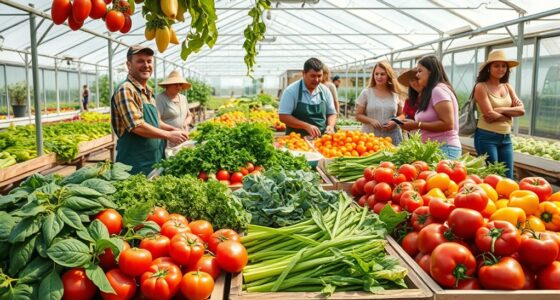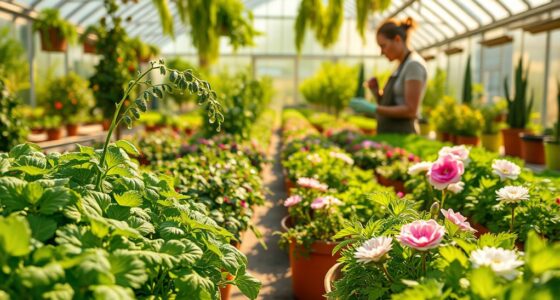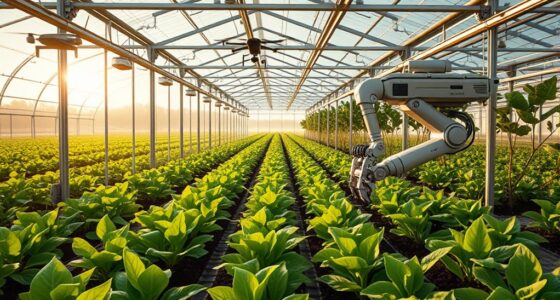By integrating chickens and fish into your greenhouse, you create a sustainable system where manure fertilizes your plants and fish help control algae and insect larvae. Chickens provide natural pest control and compost waste, while fish waste nourishes your crops. This closed-loop setup minimizes waste and conserves resources. If you’re curious about building a resilient, eco-friendly ecosystem that maximizes productivity, exploring these methods further can open up exciting possibilities.
Key Takeaways
- Raising chickens provides natural pest control and manure for composting, enriching soil and supporting plant growth in the greenhouse.
- Fish like tilapia or koi help control algae and insect larvae while their waste nourishes water and plants in a closed-loop system.
- Integrating poultry and fish creates a self-sustaining ecosystem, reducing waste and conserving resources through nutrient recycling.
- Using eco-friendly techniques such as rainwater harvesting, solar-powered pumps, and natural filtration enhances system sustainability.
- Ensuring compliance with local regulations and maintaining proper environmental controls promotes responsible, resilient greenhouse operations.
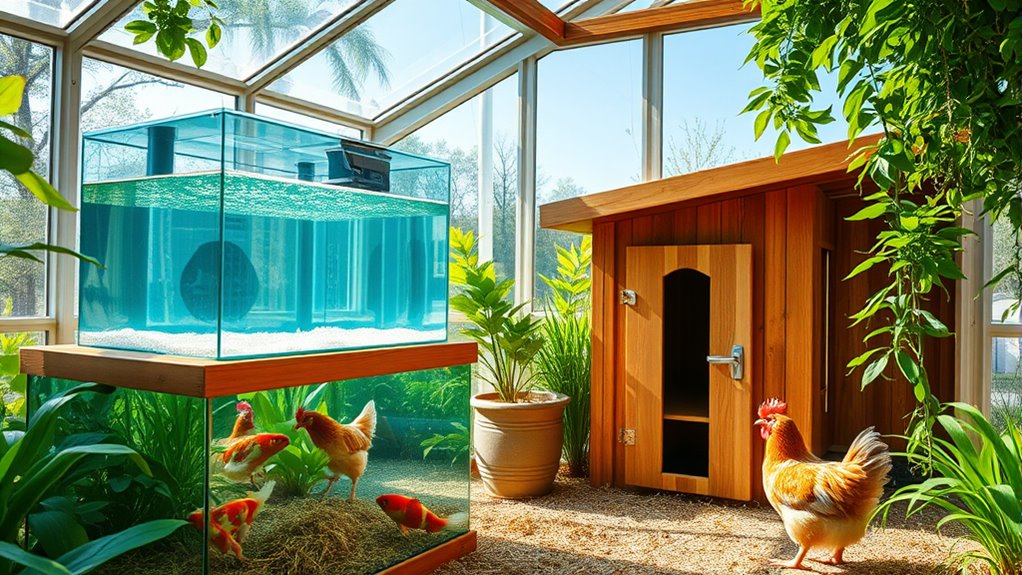
Have you ever wondered how complex technology functions seamlessly together? When it comes to integrated systems, especially those designed for sustainable agriculture, the answer lies in the clever combination of natural processes and innovative techniques. If you’re considering raising chickens or fish to benefit your greenhouse, understanding how these elements work in harmony can unlock incredible efficiencies and eco-friendly advantages. Integrated systems are all about creating a balanced environment where every component supports the others, reducing waste and conserving resources.
Integrated systems blend natural cycles and innovative techniques for sustainable, efficient greenhouse farming.
Incorporating poultry or aquaculture into your greenhouse isn’t just about adding animals; it’s about designing a system that maximizes sustainability. For example, chickens can provide natural pest control and produce manure that’s rich in nutrients, which you can compost and use to fertilize your plants. This practice embodies sustainable practices by recycling organic waste, decreasing reliance on chemical fertilizers, and lowering your overall environmental impact. Similarly, raising fish such as tilapia or koi can serve as a source of fresh protein while also helping to control algae and insect larvae in water systems. Their waste contributes nutrients to water, which can be circulated to nourish plants, creating a closed-loop cycle that minimizes waste.
Using eco-friendly techniques, you can optimize these integrated systems further. For example, employing rainwater harvesting and natural filtration methods ensures your water sources stay clean and reduce dependency on external supplies. Additionally, designing your greenhouse with energy-efficient systems, like solar-powered pumps and LED lighting, complements the eco-conscious approach. These techniques help you maintain a healthy environment for your animals and plants while reducing your carbon footprint. Incorporating air quality management strategies, such as air purifiers with HEPA filters and proper ventilation, can also improve the overall health of your ecosystem. Furthermore, understanding cybersecurity measures can help protect your digital systems that monitor and control these environmental processes.
Creating a synergistic setup requires careful planning but pays off through increased productivity and sustainability. You’ll find that the waste produced by chickens and fish can be converted into valuable resources, such as compost or nutrient-rich water, that support plant growth. This interconnected approach not only boosts crop yields but also fosters a resilient, self-sustaining ecosystem within your greenhouse. It’s about working smarter, not harder, by leveraging natural biological cycles and eco-friendly practices to create a balanced environment. Additionally, understanding Gold IRA principles might seem unrelated but emphasizes the importance of strategic planning and diversification to ensure long-term stability, which can inspire similar planning in sustainable agriculture systems.
In essence, integrated systems that raise chickens or fish to benefit your greenhouse are a practical application of sustainable practices and eco-friendly techniques. They demonstrate how technology and nature can work together to produce food efficiently while minimizing environmental impact. For instance, nutrient recycling plays a crucial role in maintaining soil fertility and water quality within these systems. Incorporating regulatory frameworks ensures these practices comply with local laws and standards, promoting responsible and sustainable operation. By embracing this holistic approach, you turn your greenhouse into a thriving, sustainable space—where every element supports the others, creating a healthier planet and a more productive growing environment.
Frequently Asked Questions
What Are the Initial Costs for Setting up Integrated Systems?
Your initial investment for setting up integrated systems can vary based on size and complexity. Startup expenses include purchasing equipment, such as tanks or coops, and installing systems to support chickens or fish. You’ll also need to budget for supplies, feed, and possible modifications to your greenhouse. While costs can seem high upfront, the benefits of sustainable production often outweigh the initial expenses, leading to long-term savings and productivity.
How Much Space Is Required for Chickens or Fish in a Greenhouse?
You’ll need to take into account space requirements and enclosure dimensions for chickens or fish in your greenhouse. For chickens, plan for at least 2-3 square feet per bird inside a well-ventilated coop. Fish tanks or ponds vary, but generally, allocate a minimum of 1 gallon of water per inch of fish. Make certain your space allows proper circulation and access to maintain healthy animals, making your setup productive and humane.
What Are the Common Health Issues for Chickens or Fish in Such Systems?
Imagine walking into your greenhouse and noticing signs of trouble—perhaps sluggish chickens or discolored fish. Common health issues include disease management challenges like respiratory infections or parasitic infestations. You might also face nutrition challenges that weaken their immune systems. Staying vigilant helps you catch problems early. Regular monitoring, proper sanitation, and balanced nutrition are key to preventing these issues, ensuring your animals stay healthy and productive in your integrated system.
How Do Integrated Systems Impact Greenhouse Climate Control?
Integrated systems substantially impact your greenhouse climate control by enhancing climate regulation and moisture control. You benefit from natural temperature moderation as animals produce heat, reducing energy costs. Moisture levels are better managed through waste absorption and evaporation, preventing excess humidity that can cause mold or plant stress. Overall, these systems create a more stable environment, leading to healthier plants and animals while optimizing resource use and reducing your operational challenges.
Are There Specific Legal Regulations for Raising Animals in Greenhouses?
Imagine a world where your greenhouse and local laws dance together—this is where regulations come into play. You must navigate zoning laws and animal welfare regulations, which vary by location. These laws ensure ethical treatment and proper space for raising animals. Before starting, check local ordinances to guarantee your plans align with legal standards, safeguarding both your operation and animal well-being.
Conclusion
By integrating chicken or fish systems into your greenhouse, you can boost productivity and sustainability. For example, aquaponics combines fish and plants, reducing water use by up to 90%. This approach not only maximizes space but also creates a self-sustaining ecosystem. Embracing these techniques can lead to healthier crops and livestock, saving you money and resources. Start exploring integrated systems today — your greenhouse’s efficiency and your bottom line will thank you.
